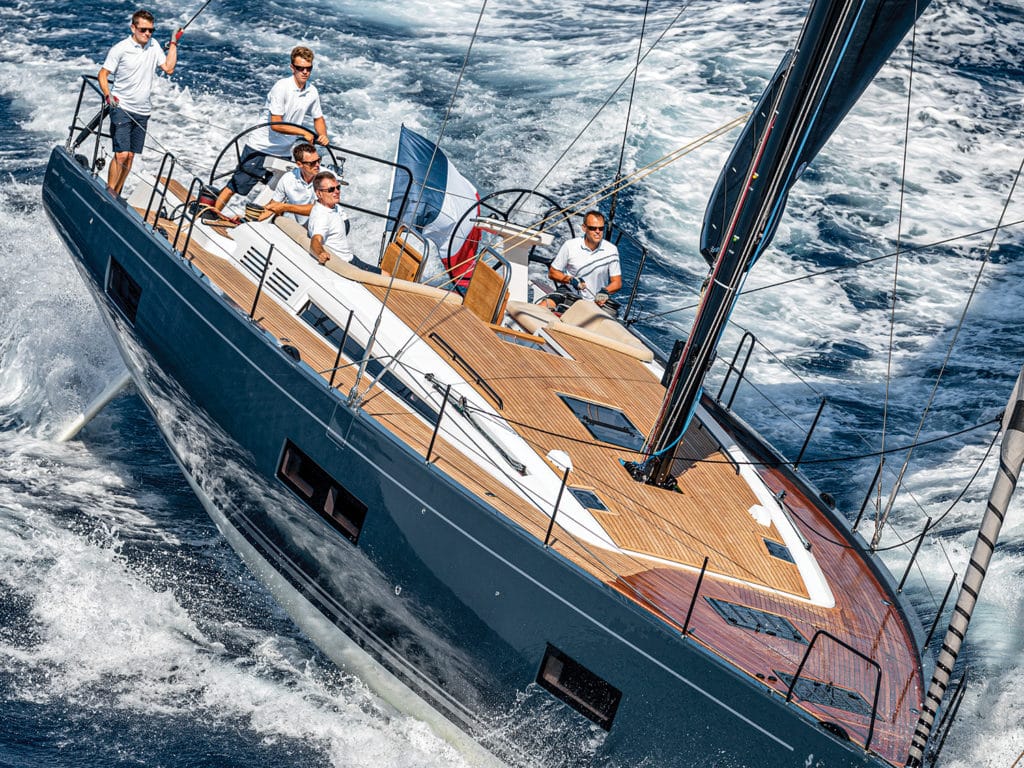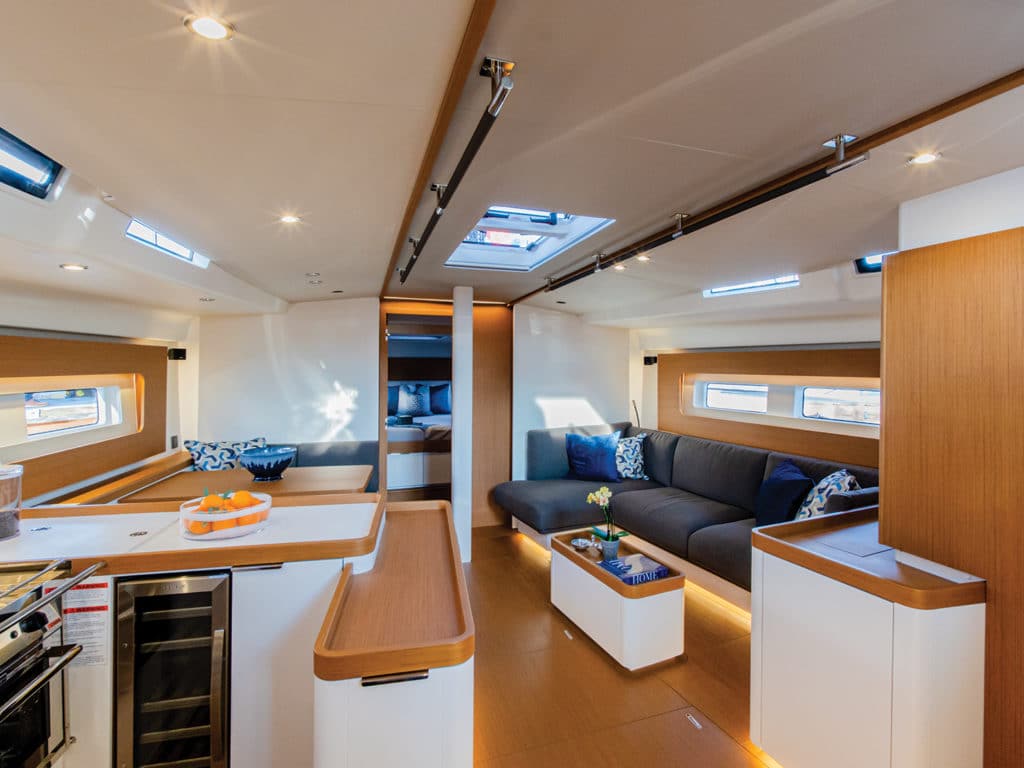
A freshening breeze, building from near calm to the midteens, brought perfect conditions for a morning sail on the new Beneteau First Yacht 53. With sails up, our speed over the ground effortlessly matched that of the light breeze, and when things got puffy out on Chesapeake Bay a bit later, well, we went soaring.
Standing atop an angled fold-up helmsmen perch at the starboard wheel, with the lee rail close to buried and the windward rudder completely out of the water, I had the otherworldly feeling of flying across the water, and it was absolutely a thrill. Think high-end sports car winding through the gears on a twisting mountain road, and, well, you get the idea: Power on and knuckles white, but it was a ride you’d not want to miss.
Beneteau introduced the First range in 1977, with racing sailors in mind. Most recently, the French builder refreshed the line with several smaller, sporty models it acquired when it bought Seascape Yachts. The 53, though, is a whole new concept entirely. Luxury performance is how it’s put in the marketing material, and, in all honesty, that’s a pretty apt description.
Walking the docks at the US Sailboat Show in Annapolis, Maryland, this past fall, the First 53’s plumb bow, slight reverse sheer, dark metallic hull, and broad deck and coach roof all covered in teak made it instantly stand out from the sea of white production cruisers. Even tied up, the boat looked ready to rip.
The First’s performance potential comes thanks to Biscontini Yacht Design and Roberto Biscontini, who earned his drawing creds over the course of two decades of America’s Cup campaigns. And the luxury? Well, Beneteau turned to Lorenzo Argento for deck and interior styling. Argento has been involved with a number of high-end projects, including Wally Yachts. Together, the pair created a vessel that’s easy to look at and riveting to sail.
A quick peak at the 53’s performance ratios, as well as a few other numbers, begins to tell the story. Its displacement-length ratio is a very sporty 118 (a fast-cruising X-Yacht clocks in at 161), while its sail area-displacement is a whopping 27.1—right on par with an all-out racer such as the Jeanneau Sunfast 3300’s SA/D of 27.6. And that’s for the standard First 53, which comes with an 8-foot-2-inch cast-iron T-keel and 85-foot aluminum mast. You can up the muscle power further by ordering the boat with a carbon-fiber rig that’s a full meter taller, and a 9-foot-10-inch performance T-keel with a lead bulb down deep, where it counts. Owners can choose sails of their liking, but Beneteau offers the 53 with a set from North Sails that includes North Panel Laminate main, 105 percent genoa and a code zero, so right out of the box, the boat’s regatta-ready.
On deck, the layout is at once simple, elegant and purposeful. All lines, including the double-ended mainsheet, run under panels back to twin helms, where controls for the electric below-deck jib furler, fold-down bow thruster, swim platform, house- and navigation-lighting systems, and matching sets of engine controls are mounted on pedestals, along with B&G plotters and instrument displays. Just forward of each wheel, a pair of Harken Performa electric winches sit adjacent to banks of line clutches.
The open transom is enclosed by lifelines, with a sturdy handhold on the centerline and solid stanchions and rails that curve around each quarter. With the boat heeling, these provide places for the crew to brace themselves if standing, or act as handholds when navigating the boat’s 16-plus-foot beam—a formidable amount of open space between steering stations.

Forward of the wheels, long cockpit seats await the crew. Each has its own teak table that does double duty as a sturdy place to grab if moving about. Beneteau has introduced a neat feature on this boat: The cockpit coamings drop to pass under the winches and past the wheels, giving crewmembers a place to sit when trimming, and the skipper a seat while steering. They don’t run all the way to the transom, though, which allows crew to pass behind either wheel and take an easy step up onto the deck when going forward. It was a detail I liked quite a bit, along with the 25-inch lifelines set atop 3-inch bulwarks all around.
Underway, I found that I had just about everything to maneuver the boat at my fingertips. As I said at the outset, conditions were light at first. In just under 5 knots of wind, we cranked along closehauled at nearly 6 knots. Later, with the breeze up to 15 or a little higher, the speedo hovered in the 8-to-9-knot range, and I saw 10 and a little more when we cracked off to a reach and unrolled the code zero.
My Beneteau-dealer shipmates suggested reefing the main at 13 to 14 knots. We didn’t, of course, and though we were overpowered a bit, judging by the angle of heel, the boat seemed to like it just fine, and so did we. And when it came time to tack, feathering up even a little quickly tamed things. There is no traveler available for the 53. Instead, the mainsheet runs through a centerline block mounted just forward of the wheels, the theory being that anyone paying in the $1.2 million ballpark for this size boat likely will spend more time cruising than racing.
Down below, Argento and Team Beneteau came up a refreshingly new approach to accommodations. White lacquered bulkheads and panels, coupled with a teak sole and molded wood furniture, kept the interior quite bright. In place of the traditional large dining area found in most boats these days, a well-equipped galley, complete with a home-size fridge, and a small dinette (expandable to seat six or so) took up the port side of the saloon. Opposite was a large L-shaped couch and small table for entertaining. Fiddles on counters and handholds were plentiful. And throughout the boat, lights and other electrical equipment were controlled by Beneteau’s proprietary Ship Control electrical system, which can be accessed using a smartphone.
The owner’s cabin was forward, and featured a split head and shower. Two more cabins were aft, with a shared head to starboard at the foot of the companionway. A three-cabin, three-head layout is also available, but it would cost you space in the galley.
The First 53’s hull and deck are cored and infused, with solid glass wherever hardware is mounted. An inner hull liner takes up loads from the mast, chainplates and engine. An 80 hp Yanmar diesel and saildrive come standard; the boat we tested was powered by the optional 110 Yanmar with shaft drive. Beneteau offers several other electronics and equipment packages as well.
If a boat is to be judged by how well it meets its design brief, the First Yacht 53 is already a winner. And did I mention? The sailing was out of this world.
Mark Pillsbury is CW’s editor.
SPECIFICATIONS – Beneteau First Yacht 53
| LENGTH OVERALL | 56’4″ (17.17 m) |
|---|---|
| WATERLINE LENGTH | 50’6″ (15.39 m) |
| BEAM | 16’5″ (5 m) |
| DRAFT (Standard/Performance) | 8’2″/9’10” (2.49/3.00 m) |
| SAIL AREA (100%) | 1,785 sq. ft. (165.8 sq. m) |
| BALLAST | 9,920 lb. (4,500 kg) |
| DISPLACEMENT | 34,171 lb. (15,500 kg) |
| BALLAST/DISPLACEMENT | 0.29 |
| DISPLACEMENT/LENGTH | 118 |
| SAIL AREA/DISPLACEMENT | 27.1 |
| WATER | 190 gal. (720 L) |
| FUEL | 106 gal. (400 L) |
| HOLDING | 21 gal., 13 gal. (79 L, 49 L) |
| MAST HEIGHT | 85’0″ (25.91 m) |
| ENGINE | 110 hp Yanmar (80 hp Yanmar standard) |
| DESIGNER | Biscontini Yacht Design, interior and deck by Lorenzo Argento |
| PRICE | $1,155,800 |
Beneteau
410-990-0270








